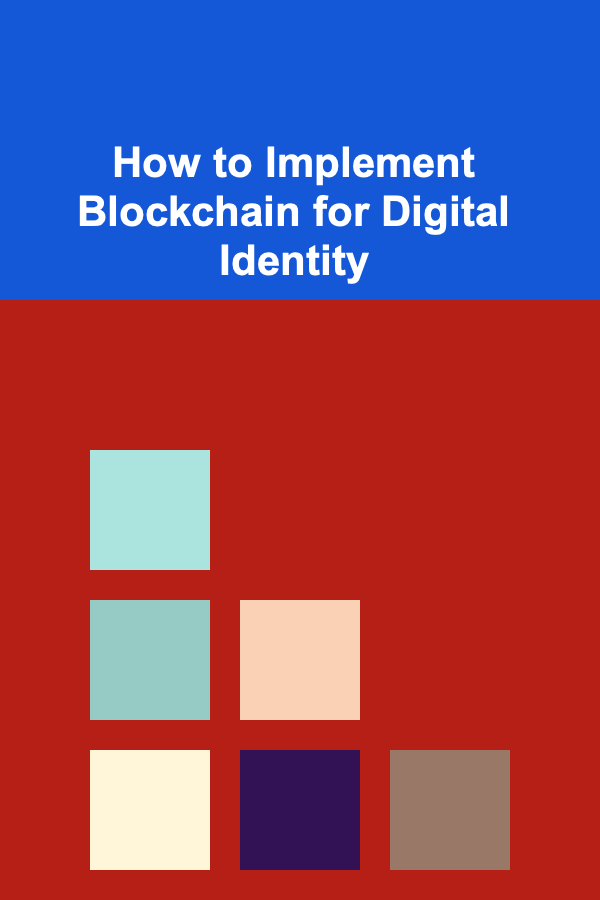
How to Implement Blockchain for Digital Identity
ebook include PDF & Audio bundle (Micro Guide)
$12.99$6.99
Limited Time Offer! Order within the next:

The implementation of blockchain technology for digital identity management is a groundbreaking innovation that holds the potential to reshape the way individuals, organizations, and governments handle personal data. With increasing concerns over privacy, data breaches, and fraud, the need for a secure, transparent, and decentralized system for digital identity is more pressing than ever. Blockchain, with its decentralized, immutable, and transparent characteristics, is the ideal technology to address these challenges.
In this article, we will explore the concept of digital identity, the role of blockchain in its management, and how blockchain can be implemented for secure digital identity systems. We will examine the technical and organizational considerations, as well as the benefits and challenges associated with this technology.
What is Digital Identity?
Digital identity refers to the online representation of an individual, organization, or entity, which includes the use of various identifiers, credentials, and attributes to prove identity in digital environments. It is essential in online transactions, accessing services, and interacting with digital platforms. Traditionally, digital identity has been managed by centralized systems, such as governments, banks, and tech companies, which store and authenticate user data.
However, the centralized model has several weaknesses, including:
- Data Breaches: Centralized databases are vulnerable to hacking and data theft, potentially compromising personal information.
- Privacy Concerns: Centralized systems have access to vast amounts of personal data, raising concerns about misuse, surveillance, and lack of user control.
- Fraud and Identity Theft: Centralized systems are susceptible to identity theft, fraud, and identity manipulation.
- Lack of Interoperability: Different identity providers use incompatible systems, making it difficult for users to seamlessly access various services with a single identity.
To address these challenges, blockchain technology offers a decentralized, secure, and transparent solution for managing digital identities.
What is Blockchain and How Does It Work?
Blockchain is a distributed ledger technology that allows data to be stored in a decentralized manner across multiple nodes (computers or devices) in a network. Each block in the blockchain contains a set of transactions or data entries, and once a block is added to the chain, it cannot be altered or deleted, ensuring the immutability of the data.
The key characteristics of blockchain technology are:
- Decentralization: Blockchain operates on a peer-to-peer network, meaning there is no central authority or intermediary controlling the data. This makes it resistant to censorship and manipulation.
- Immutability: Once data is recorded on the blockchain, it cannot be altered or deleted, providing a permanent and verifiable record of transactions or events.
- Transparency: All transactions on the blockchain are publicly accessible and can be verified by anyone with access to the network. This ensures trust and accountability.
- Security: Blockchain uses cryptographic algorithms to secure data, making it difficult for unauthorized parties to tamper with or alter the information.
These characteristics make blockchain an ideal solution for managing digital identities, where security, transparency, and control are paramount.
How Blockchain Can Be Used for Digital Identity Management
Blockchain can be applied to digital identity management in several ways, providing a more secure, user-centric, and efficient alternative to traditional systems. Here are the key steps and components involved in implementing blockchain for digital identity:
1. Self-Sovereign Identity (SSI)
One of the most promising applications of blockchain for digital identity is the concept of Self-Sovereign Identity (SSI). SSI is a decentralized model where individuals have full control over their own identity and personal data. Instead of relying on a central authority to issue and manage identities, users can create and manage their own digital identities on the blockchain.
In the SSI model, individuals are the sole owners of their identity, and they control which data is shared with third parties. This gives users greater privacy and control over their personal information, reducing the risks associated with data breaches and identity theft.
Key Features of SSI:
- Decentralized Control: Users create and control their own digital identity without the need for intermediaries.
- Privacy and Security: Personal data is encrypted and stored in a way that only the user has access to it. Data is shared only with the user's consent.
- Interoperability: SSI allows users to use their identity across different platforms and services, without the need to create new accounts or credentials each time.
- Verifiable Credentials: Users can issue, share, and verify credentials (such as certificates, licenses, and memberships) on the blockchain, ensuring authenticity and trustworthiness.
2. Decentralized Identifiers (DIDs)
Decentralized Identifiers (DIDs) are a core component of SSI. DIDs are unique identifiers that are created, owned, and controlled by the user, rather than a central authority. These identifiers are stored on the blockchain and can be used to authenticate and verify a user's identity.
Unlike traditional identifiers such as email addresses or social security numbers, DIDs are not tied to any central entity or organization. They are fully decentralized and can be linked to verifiable credentials, which are also stored on the blockchain.
How DIDs Work:
- A user creates a DID, which is a unique, globally recognized identifier.
- The DID is associated with a DID document, which contains the user's public key and other relevant information (such as the user's name or organization).
- The user can use the DID to authenticate themselves on different platforms and services, without relying on a central authority.
DIDs provide users with control over their digital identity and allow for secure, privacy-preserving interactions in a decentralized manner.
3. Verifiable Credentials
Verifiable credentials (VCs) are digital statements that are issued by a trusted authority and can be used to prove aspects of a user's identity. These credentials are cryptographically signed and can be verified by anyone, ensuring that the information is authentic and tamper-proof.
For example, a government agency might issue a verifiable credential to a user, stating that they are of legal age to purchase alcohol. This credential would be stored on the blockchain, and the user could share it with vendors to prove their age, without revealing any other personal information.
Key Features of Verifiable Credentials:
- Cryptographic Signatures: Credentials are digitally signed by trusted authorities, ensuring their authenticity.
- Privacy-Respecting: Only the necessary information is shared. For example, a user can prove they are over 18 without revealing their exact birthdate.
- Interoperability: Verifiable credentials can be used across various platforms and services, making them a versatile solution for digital identity management.
4. Blockchain for Identity Authentication
Blockchain can be used to authenticate users by leveraging cryptographic techniques such as digital signatures and public-private key pairs. In a blockchain-based identity system, users can authenticate themselves by proving ownership of a private key that corresponds to their DID.
When a user wants to authenticate on a platform, they can use their private key to sign a message or transaction. The platform can then verify the signature using the user's public key, which is stored on the blockchain. This process ensures that the user is who they claim to be, without the need for passwords or other traditional authentication methods.
5. Smart Contracts for Identity Verification
Smart contracts are self-executing contracts with the terms of the agreement directly written into code. In the context of digital identity, smart contracts can be used to automate the process of identity verification and credential issuance.
For example, a smart contract could automatically verify a user's credentials (such as a university degree) and issue a digital certificate that is stored on the blockchain. Smart contracts can also be used to enforce privacy policies, ensuring that users only share the minimum amount of information required for a transaction.
Key Benefits of Blockchain for Digital Identity
Implementing blockchain for digital identity management offers several key benefits:
1. Enhanced Security and Privacy
Blockchain's cryptographic algorithms ensure that data is securely stored and transmitted. Since users control their own data and have the ability to share it selectively, the risks of data breaches and identity theft are significantly reduced.
2. Decentralization and User Control
With blockchain, digital identity management is decentralized, meaning there is no central authority that controls or stores user data. This gives users full control over their personal information, reducing the risks associated with centralized data storage systems.
3. Reduced Fraud and Identity Theft
Blockchain's immutability ensures that once data is recorded, it cannot be altered or deleted. This makes it difficult for fraudsters to manipulate or forge identity documents, reducing the risk of identity theft and fraud.
4. Improved Efficiency and Cost Savings
By eliminating intermediaries and automating identity verification processes, blockchain can streamline identity management, making it more efficient and cost-effective for both users and organizations.
5. Interoperability
Blockchain-based digital identity systems can be used across different platforms and services, allowing users to access multiple services with a single, trusted identity. This enhances the user experience and reduces the need for multiple accounts and credentials.
Challenges and Considerations
While blockchain offers significant advantages for digital identity management, there are several challenges and considerations to address:
1. Scalability
Blockchain networks can be slower and less scalable than traditional centralized systems, particularly when handling large volumes of transactions. Solutions such as layer 2 scaling and sharding are being explored to address these issues.
2. User Adoption
For blockchain-based digital identity systems to be successful, they must be widely adopted by users, service providers, and governments. Achieving mass adoption will require education, incentives, and interoperability between different platforms.
3. Regulatory Compliance
Blockchain-based identity systems must comply with existing data protection and privacy regulations, such as the GDPR in Europe. Ensuring that blockchain solutions adhere to these regulations will be crucial for their success.
4. Security Risks
While blockchain itself is secure, the broader ecosystem of digital identity systems (such as wallets, private keys, and smart contracts) must also be secure. Users must take steps to protect their private keys and ensure that their identity data is not exposed to malicious actors.
Conclusion
Implementing blockchain for digital identity management offers a transformative solution for securing, decentralizing, and improving the efficiency of digital identity systems. Through self-sovereign identities, decentralized identifiers, verifiable credentials, and blockchain-based authentication methods, individuals can take control of their personal data while enjoying greater security and privacy.
Despite challenges related to scalability, adoption, and regulatory compliance, the potential benefits of blockchain in digital identity management are immense. As blockchain technology continues to evolve, it is likely that we will see widespread adoption of decentralized identity solutions, paving the way for a more secure, transparent, and user-centric digital future.
Other Products

How to Add Lighting to Your Entryway to Make a Great First Impression
Read More
How to Choose the Right Lighting for Your Home's Outdoor Spaces
Read More
How to Decorate Your Bathroom Without Spending a Fortune
Read More
How To Grow Your Small Business Organically
Read More
How to Personalize Your SMS Messages for Better Abandoned Cart Recovery in Dropshipping
Read More